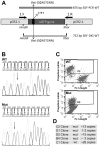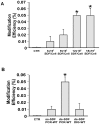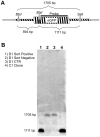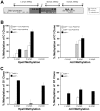Small fragment homologous replacement: evaluation of factors influencing modification efficiency in an eukaryotic assay system
- PMID: 22359552
- PMCID: PMC3281040
- DOI: 10.1371/journal.pone.0030851
Small fragment homologous replacement: evaluation of factors influencing modification efficiency in an eukaryotic assay system
Abstract
Homologous Replacement is used to modify specific gene sequences of chromosomal DNA in a process referred to as "Small Fragment Homologous Replacement", where DNA fragments replace genomic target resulting in specific sequence changes. To optimize the efficiency of this process, we developed a reporter based assay system where the replacement frequency is quantified by cytofluorimetric analysis following restoration of a stably integrated mutated eGFP gene in the genome of SV-40 immortalized mouse embryonic fibroblasts (MEF-SV-40). To obtain the highest correction frequency with this system, several parameters were considered: fragment synthesis and concentration, cell cycle phase and methylation status of both fragment and recipient genome. In addition, different drugs were employed to test their ability to improve technique efficiency. SFHR-mediated genomic modification resulted to be stably transmitted for several cell generations and confirmed at transcript and genomic levels. Modification efficiency was estimated in a range of 0.01-0.5%, further increasing when PARP-1 repair pathway was inhibited. In this study, for the first time SFHR efficiency issue was systematically approached and in part addressed, therefore opening new potential therapeutic ex-vivo applications.
Conflict of interest statement
Figures








Similar articles
-
Small Fragment Homologous Replacement (SFHR): sequence-specific modification of genomic DNA in eukaryotic cells by small DNA fragments.Methods Mol Biol. 2014;1114:85-101. doi: 10.1007/978-1-62703-761-7_6. Methods Mol Biol. 2014. PMID: 24557898
-
Cftr gene targeting in mouse embryonic stem cells mediated by Small Fragment Homologous Replacement (SFHR).Front Biosci. 2008 Jan 1;13:2989-99. doi: 10.2741/2904. Front Biosci. 2008. PMID: 17981772 Free PMC article. Review.
-
Expression of human poly (ADP-ribose) polymerase 1 in Saccharomyces cerevisiae: Effect on survival, homologous recombination and identification of genes involved in intracellular localization.Mutat Res. 2015 Apr;774:14-24. doi: 10.1016/j.mrfmmm.2015.02.006. Epub 2015 Mar 6. Mutat Res. 2015. PMID: 25779917
-
1,5-isoquinolinediol increases the frequency of gene targeting by homologous recombination in mouse fibroblasts.Biochem Cell Biol. 2003 Feb;81(1):17-24. doi: 10.1139/o02-172. Biochem Cell Biol. 2003. PMID: 12683632
-
Involvement of poly(ADP-ribose) polymerase in base excision repair.Biochimie. 1999 Jan-Feb;81(1-2):69-75. doi: 10.1016/s0300-9084(99)80040-6. Biochimie. 1999. PMID: 10214912 Review.
Cited by
-
The Gene Targeting Approach of Small Fragment Homologous Replacement (SFHR) Alters the Expression Patterns of DNA Repair and Cell Cycle Control Genes.Mol Ther Nucleic Acids. 2016 Apr 5;5(4):e304. doi: 10.1038/mtna.2016.2. Mol Ther Nucleic Acids. 2016. PMID: 27045208 Free PMC article.
References
Publication types
MeSH terms
Substances
LinkOut - more resources
Full Text Sources
Miscellaneous

